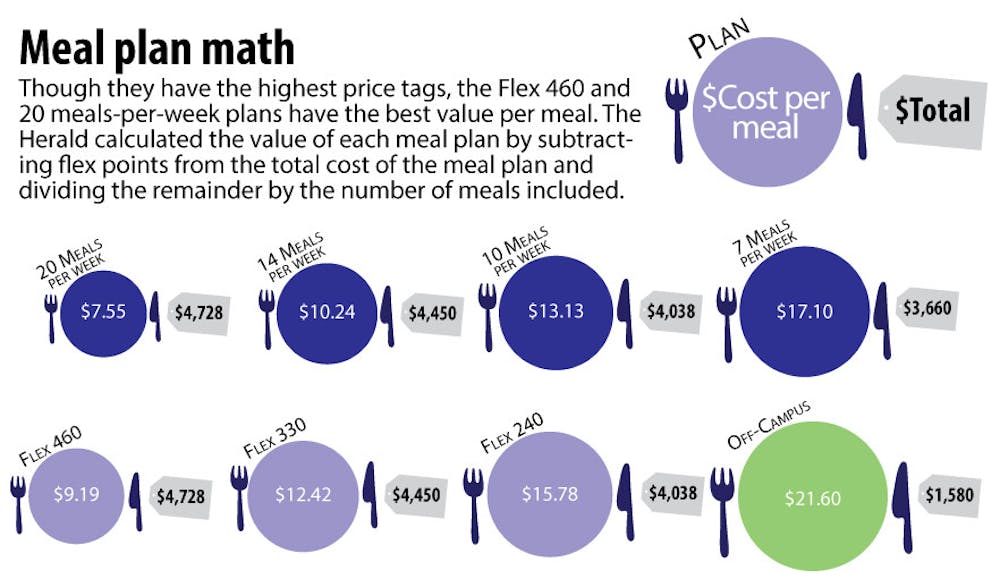Students have just one week left to decide on a meal plan before the Sept. 30 deadline for changing or canceling a meal plan. The eight primary meal plans — three “flex” varieties, four fixed meal varieties and an off-campus plan — are priced differently and offer dramatically different values.
The Herald calculated the approximate cost per meal for each plan by subtracting flex points — which are equal to $1 each — from the total and dividing the remainder by the total number of meals included in the plan. The results were clear: The meal plans with the highest total price tag offer the best per-meal value.
Though it is the most expensive meal plan, the 20-meals-per-week plan is the best deal at $7.55 per meal, while a single meal on the off-campus plan is the costliest at $21.60, according to the calculations. For comparison, Brown Dining Services uses $7.30 as the meal credit equivalent in campus eateries.
Meals on the flex plans are more costly than their equivalent fixed meal plans. A meal on the Flex 460 plan costs $9.19, compared to $7.55 for the 20-meals-per-week plan, which has the same total price. Meals on the Flex 330 and Flex 240 plans cost $12.42 and $15.78, respectively.
As the total price tag and number of meals for meal plans declines, the average meal becomes more expensive. For example, the 14-meals-per-week plan costs $10.24 per meal, while meals on the 10-meals-per-week and seven-meals-per-week plans cost $13.13 and $17.10, respectively.
Approximately 72 percent of students on one of the meal plans chose either 20 meals per week or Flex 460 during the last academic year, wrote Gretchen Willis, director of Dining Services, in an email to The Herald.
“I do believe that meal plan is a good value,” Willis wrote.
Students expressed preferences for certain meal plans based on convenience and value.
“Flex 460 is a better deal than Flex 330,” said AJ Whitman ’17, who chose the plan in order to “never have to worry about food.”
“I can’t say it’s the best deal, but it’s not horrible. I have easy access to food and don’t have to cook,” Whitman said.
Shanelle DeJournett ’17 also expressed satisfaction with Flex 460. “I’m an athlete, so I’m terrible at going to breakfast — sometimes I don’t even have time for lunch,” she said. “On Flex 460, I can spend points on cereal and snacks.”
But DeJournett added, “I feel like (the University is) jacking up the prices.”
William Martin ’18 is on the 20-meals-per-week plan — the plan with the best calculated value. The plan is “a reliable source of getting something to eat,” he said.
“It’s cheaper to cook for yourself, but it’s very inconvenient,” Martin said. “I think the price of a meal plan is worth avoiding the hassle.”
But after freshman year, when being on a meal plan is no longer mandatory, some students choose to forge their own culinary paths.
“Going off meal plan is one of the best economic decisions I’ve made in college,” said Chris Bey-Musick ’17. After freshman year, “I realized it would involve a lot of extra money to eat out or cook for myself to change things up,” he said. “As someone who’s low-income, that’s really difficult.”
“One of my biggest gripes is going to the marketplaces, like the (Josiah’s) mini-mart and the Campus Market. The price mark-ups there are absolutely ridiculous,” Bey-Musick said. “They’re definitely taking advantage of the fact that we as students don’t have transportation or time to go other places, which I find unethical personally.”

ADVERTISEMENT




